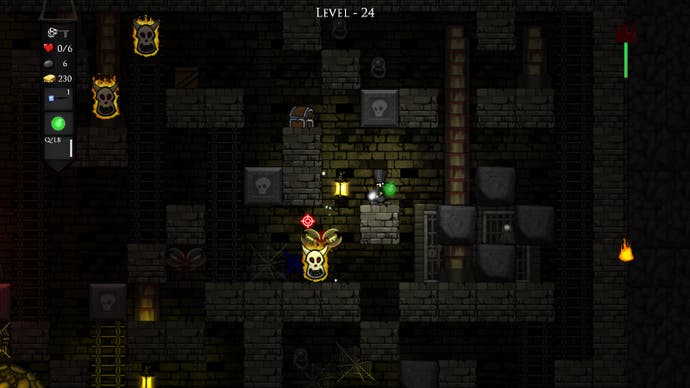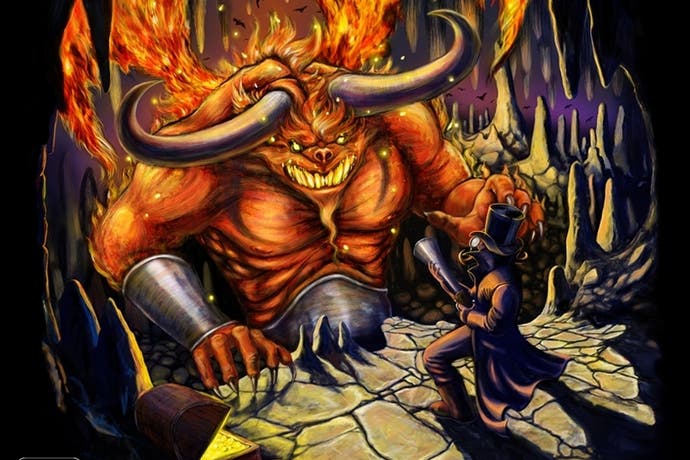99 Levels to Hell review
Way down in the hole.
Roguelikes must feel like chemistry sets to designers - they must feel like the cool ones you got as a kid which allowed you a limited creative licence to meddle, to blow things up, to set things on fire. I suspect that this kind of playful tinkering is where 99 Levels to Hell was born, with the developer taking an existing roguelike design template as a starting point - specifically Spelunky's brilliant twist on the roguelike as platformer - before tweaking, rearranging and then standing back to see what happened.
That's not to say 99 Levels is a clone. Spelunky's Derek Yu was working with established ideas in the first place, and ZaxisGames' dungeon-crawler brings a handful of additional concepts to bear. The main shift in focus is that - like The Binding of Isaac - 99 Levels is a shooter from the off, and one in which you're wise to keep your finger firmly clamped on the trigger throughout. Played with a decent pad, which is the way I suggest you approach things, the game is a fairly decent blaster, actually: enemies swarm in from all angles, crowds of foes require constant management, and you have to keep your reticule spinning around you in order to fend them off when things get really bad.

A sharper focus on shooting's not the only twist. The exit to each individual level now requires a key before you can pass through it, which means you've basically got two main objectives when spawning in a new stage instead of just one. That exit - and the entrance, in fact - can be located anywhere, too, meaning you're going to have to hunt high as well as low as you play. With no rope system in place, you can expect to get into a right pickle now and then, particularly when you're encountering levels filled with dirt that can collapse beneath you - but while the design employs a certain degree of randomisation each time you restart the game, the roll of the dice is largely focused on item placement and will never chuck you into a level that can't be completed.
Every tenth level pits you against a boss, which drives home the emphasis on shooting while also providing a handy means of unlocking new starting positions. The bosses aren't bad in general, although they're delivered, like the rest of the game, via a fairly anonymous cartoon art style that could best be described as 'early era Clinton's Cards'. These larger monsters are pleasantly tough to take down even if they're slightly lacking in terms of animated hit responses, and they have a winning habit of spawning waves of smaller critters who will often do you in even after you think you've been victorious. As with most good roguelikes, the best way to get yourself killed is to start cutting corners; the graveyards are filled with randomised heroes whose fatal flaws all trace back to cockiness.

It's relatively entertaining stuff: the items you randomly encounter change the game in a variety of mysterious ways, buffing your weapons, swapping in new wands or guns, providing rechargeable powers, or perhaps turning you into Mario and allowing you to stomp on enemies for a few seconds, while the rather slow pace of progress as you plod through such fiercely challenging gauntlets is enlivened now and then by elevators and umbrellas that allow you to click forward a few levels and get a taste of what's to come. (Watch out, though: those elevators will often take you back a few levels, instead.) Elsewhere, you can cash in gold at shops, and you can search for additional characters to unlock as you play as well: characters which will come with different basic weapons and load-outs of bombs and health points.
Despite its breezy, good-natured design, 99 Levels struggles to assert its own identity over the course of the dozens of hours it's capable of consuming, however. It's a variation on a theme, which is fine, but its tweaks and new additions are often a little too good at reminding you of how brilliant Spelunky is in the first place. You know: how keeping the exit at the bottom of each stage provides a clarifying focus that allows the environments to then sprawl organically, and how creating enemies that have interlocking behaviours that move beyond simply governing the manner in which they attack turns each muddle of rooms into a believable ecosystem. Whether it's the art, the depths of its secrets or even the control layout (ZaxisGames has opted for a rather weird approach that sees jumping ending up on the left trigger) 99 Levels to Hell can't match up to its obvious inspirations. While it feels churlish to view one game through the lens of another, in this case, it's difficult not to.

